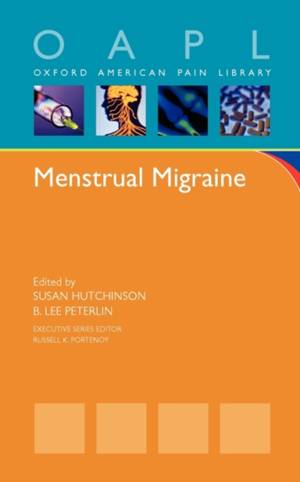
Bedankt voor het vertrouwen het afgelopen jaar! Om jou te bedanken bieden we GRATIS verzending (in België) aan op alles gedurende de hele maand januari.
- Afhalen na 1 uur in een winkel met voorraad
- In januari gratis thuislevering in België
- Ruim aanbod met 7 miljoen producten
Bedankt voor het vertrouwen het afgelopen jaar! Om jou te bedanken bieden we GRATIS verzending (in België) aan op alles gedurende de hele maand januari.
- Afhalen na 1 uur in een winkel met voorraad
- In januari gratis thuislevering in België
- Ruim aanbod met 7 miljoen producten
Zoeken
Menstrual Migraine
Susan (Director and Founder, Director and Founder, Headache Cent, Lee B. (Assistant Professor, Neurology, Assistant Professor, Neu
€ 75,95
+ 151 punten
Omschrijving
Approximately 10 million women in the US suffer from menstrual migraine, a common and disabling condition. Menstrual migraine is typically defined as a migraine headache that affects a woman each month starting two days before the menstrual period and continuing to the end of menstruation. It differs from nonmenstrual attacks of migraine, even in the same woman, in the regularity of its timing and its greater severity. Compared with other times in the menstrual cycle, a migraine is more than twice as likely to occur during the first 3 days of menstruation and more than 3 times as likely to be severe. As part of the Oxford American Pain Library, this practical handbook serves as a concise yet authoritative resource on diagnosing and treating menstrual migraine. Tailored to the needs of busy health care professionals treating female patients in the primary care setting, the book focuses on essential clinical information for physicians, nurse practitioners, and physician assistants in family practice, internal medicine and obstetrics and gynaecology.In addition to covering traditional clinical areas such as pathogenesis, co-morbidities, pharmacologic and non-pharmacologic treatments, the book also presents an array of practical tools and features such as screening tools for easy diagnosis, disability assessment tools, tips on best questions to ask, useful checklists and additional patient resource information. The handbook also provides valuable guidance on how to proceed should initial treatment efforts fail.
Specificaties
Betrokkenen
- Auteur(s):
- Uitgeverij:
Inhoud
- Aantal bladzijden:
- 112
- Taal:
- Engels
- Reeks:
Eigenschappen
- Productcode (EAN):
- 9780195368055
- Verschijningsdatum:
- 28/01/2008
- Uitvoering:
- Paperback
- Formaat:
- Trade paperback (VS)
- Afmetingen:
- 124 mm x 190 mm
- Gewicht:
- 158 g

Alleen bij Standaard Boekhandel
+ 151 punten op je klantenkaart van Standaard Boekhandel
Beoordelingen
We publiceren alleen reviews die voldoen aan de voorwaarden voor reviews. Bekijk onze voorwaarden voor reviews.









